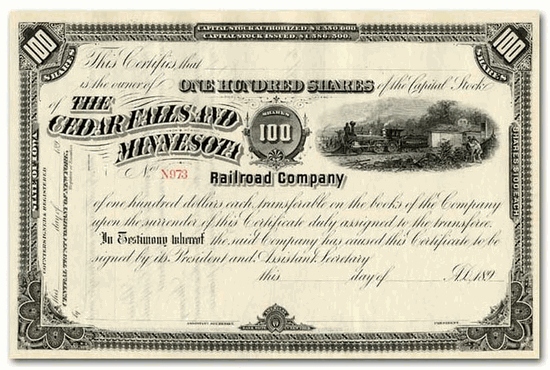Encyclopedia Dubuque
"Encyclopedia Dubuque is the online authority for all things Dubuque, written by the people who know the city best.”
Marshall Cohen—researcher and producer, CNN
Affiliated with the Local History Network of the State Historical Society of Iowa, and the Iowa Museum Association.
CEDAR FALLS AND MINNESOTA RAILROAD: Difference between revisions
No edit summary |
No edit summary |
||
| Line 1: | Line 1: | ||
[[File:cfmm.gif|300px|thumb|left|]]CEDAR FALLS AND MINNESOTA RAILROAD. The 1868 ''Guide, Gazetteer and Directory of the Dubuque & Soux (sic) City Railroad'' stated that the office of this business was located at the corner of Locust and 5th. | [[File:cfmm.gif|300px|thumb|left|]]CEDAR FALLS AND MINNESOTA RAILROAD. In 1861 the [[DUBUQUE AND SIOUX CITY RAILROAD]], connecting with the [[ILLINOIS CENTRAL RAILROAD]] and Galena and Chicago Union Roads, was nearing completion to Cedar Falls, Iowa. At this point the Cedar Falls and Minnesota Railroad, from Cedar Falls to the State line of Minnesota, was under contract to Erastus Edgerton and Company of New-York, for the sum of $1,025,000. This road was seventy-five miles long to end at Otranto, at the State line of Minnesota. There it connected with the "Cedar Valley and Minneapolis" Road, (108 miles,) extending to St. Paul. The grading on the Cedar Falls and Minnesota Road has been completed to Waverly, a distance of fifteen miles, and a bridge, spanning the Cedar River was nearly finished. The ground was so level that not a cut or filling of more than ten feet was required. | ||
The Company paid the contractors in the following manner: $600,000 of their first mortgage 7% Bonds; $40,000 Mitchell County 10% Bonds; $60,000 Floyd County 10% Bonds; $50,000 in lands, deeded along the line of road; $100,000 in cash, and $175,000 in stock and subscriptions to stock -- in all $1,025,000. The Company was to issue $650,000 of first mortgage 7% bonds, $50,000 of which was for their own account. This created a bonded debt of about $8,500 per mile. | |||
Seeing the great importance of this road, and the increased amount of traffic that must result from it, the Illinois Central, Galena and Chicago Union, and the Dubuque and Sioux City roads created a sinking fund for the cancellation of these bonds, by paying to the trustees of the Company bonds referred to, (for five years,) 15% of all the gross earnings from business passing to and from all points upon the Cedar Falls and Minnesota Railroad over the roads of the above-named companies. This gave these bonds an increased value. | |||
In 1861 the Cedar Valley and Minneapolis Road was graded sixty-five miles. It had passed into the hands of the State of Minnesota, and the work had been suspended for some time. Strong incentives were offered to any responsible parties who woud resume and finish the work. (1) | |||
--- | |||
Source: | |||
1. "New Railways in Iowa," ''The New York Times'', March 4, 1861, Online: http://www.nytimes.com/1861/03/04/news/new-railways-in-iowa.html | |||
The 1868 ''Guide, Gazetteer and Directory of the Dubuque & Soux (sic) City Railroad'' stated that the office of this business was located at the corner of Locust and 5th. | |||
[[Category: Railroad]] | [[Category: Railroad]] | ||
Revision as of 19:30, 16 October 2014
CEDAR FALLS AND MINNESOTA RAILROAD. In 1861 the DUBUQUE AND SIOUX CITY RAILROAD, connecting with the ILLINOIS CENTRAL RAILROAD and Galena and Chicago Union Roads, was nearing completion to Cedar Falls, Iowa. At this point the Cedar Falls and Minnesota Railroad, from Cedar Falls to the State line of Minnesota, was under contract to Erastus Edgerton and Company of New-York, for the sum of $1,025,000. This road was seventy-five miles long to end at Otranto, at the State line of Minnesota. There it connected with the "Cedar Valley and Minneapolis" Road, (108 miles,) extending to St. Paul. The grading on the Cedar Falls and Minnesota Road has been completed to Waverly, a distance of fifteen miles, and a bridge, spanning the Cedar River was nearly finished. The ground was so level that not a cut or filling of more than ten feet was required.
The Company paid the contractors in the following manner: $600,000 of their first mortgage 7% Bonds; $40,000 Mitchell County 10% Bonds; $60,000 Floyd County 10% Bonds; $50,000 in lands, deeded along the line of road; $100,000 in cash, and $175,000 in stock and subscriptions to stock -- in all $1,025,000. The Company was to issue $650,000 of first mortgage 7% bonds, $50,000 of which was for their own account. This created a bonded debt of about $8,500 per mile.
Seeing the great importance of this road, and the increased amount of traffic that must result from it, the Illinois Central, Galena and Chicago Union, and the Dubuque and Sioux City roads created a sinking fund for the cancellation of these bonds, by paying to the trustees of the Company bonds referred to, (for five years,) 15% of all the gross earnings from business passing to and from all points upon the Cedar Falls and Minnesota Railroad over the roads of the above-named companies. This gave these bonds an increased value.
In 1861 the Cedar Valley and Minneapolis Road was graded sixty-five miles. It had passed into the hands of the State of Minnesota, and the work had been suspended for some time. Strong incentives were offered to any responsible parties who woud resume and finish the work. (1)
---
Source:
1. "New Railways in Iowa," The New York Times, March 4, 1861, Online: http://www.nytimes.com/1861/03/04/news/new-railways-in-iowa.html
The 1868 Guide, Gazetteer and Directory of the Dubuque & Soux (sic) City Railroad stated that the office of this business was located at the corner of Locust and 5th.


